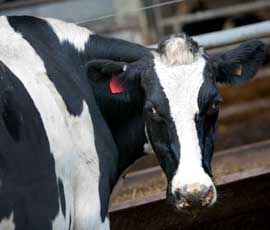Major revamp of Johne’s accreditation system

The way in which a farm’s Johne’s disease status is determined will now depend on efforts to reduce the disease, thanks to a major revamp of the disease accreditation programme.
The Cattle Health Certification Standard’s (CHeCS) Johne’s disease programme previously rated herds with clear herd tests as “qualifying” or “accredited”. However, CHeCS executive director Tim Brigstocke says this neither recognised nor rewarded farmers pro-actively tackling the disease. The term accredited was also frequently misinterpreted as meaning “free of”.
“Our new risk-based approach introduced for 2013 is designed to help herds maintain or move towards clear herd tests through a combination of testing and the implementation of a disease management programme,” he explains.
The scheme will now categorise herds on a scale of one (lowest risk) to five (highest risk) according to the risk of selling infected animals. To move off the bottom rung (five), an up-to-date health plan needs to be in place for the farm, endorsed by both the producer and his vet.
Mr Brigstocke explains that unlike infections such as BVD, Johne’s is difficult to deal with and eradication is virtually impossible.
“Available tests for Johne’s can only detect the disease as it is progressing, so for every reactor identified, more infected animals in the herd may remain undetected,” he says.
This means that tackling the disease in infected herds is a long-term prospect, involving repeated testing and the implementation of management practices to prevent the spread of infection.
“The new approach recognises the importance of a sustained programme to reduce disease incidence – but importantly, it also acknowledges that herds with clear tests may still contain infected animals, which is critical in avoiding complacency.”
The key points of the new regime are:
• Herds with three clear consecutive annual tests of all animals of two years and older with no reactors identified will gain level one status. Level one herds carry the lowest risk of selling infected stock; this category is equivalent to the current “accredited” status. The greater the number of animals in a herd and the longer it has been at level one, the lower its risk.
• Herds that have had one or more clear herd tests, but have not yet achieved level one status, will be categorised as level two.
• Herds where reactors have been identified will be classed as level three or four depending on the number of reactors in the herd. It is essential for all herds within levels one to four to have a health plan in place covering the control of Johne’s. The aim of the health plan is to reduce the spread of infection within a herd and reduce the risk of buying in infected animals. It must be updated annually and endorsed by both vet and farmer.
• Herds that do not have a health plan in place or have no evidence that they are taking steps to control the disease will be classed as level five, along with herds that do not carry out testing. Level five herds are considered to be the greatest risk in terms of Johne’s when buying in replacement stock.
• Any calf at foot of a reactor must not be retained for breeding or sold as a breeding animal. This is because these calves are considered to be more likely to be infected than calves of dams that test negative.
Hear how a Welsh producer is looking to tackle Johne’s disease
